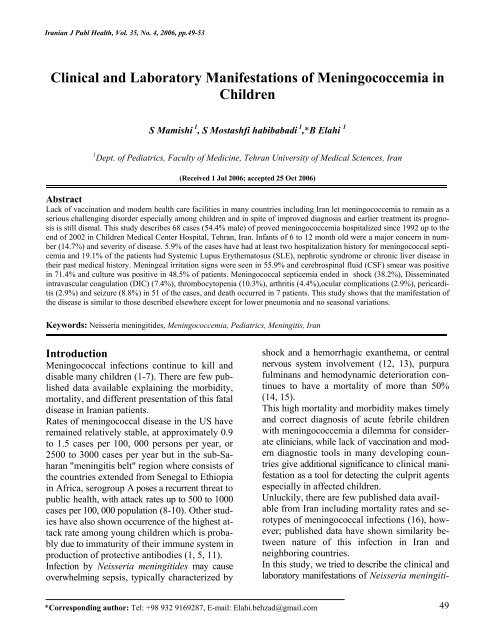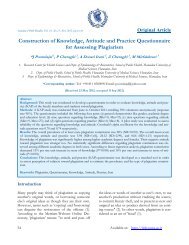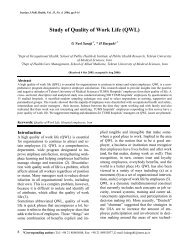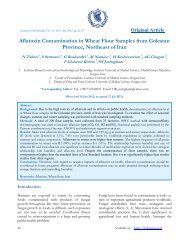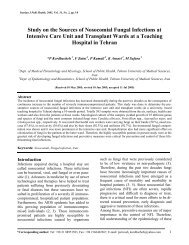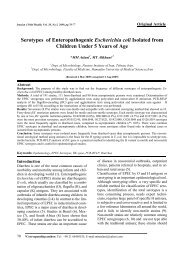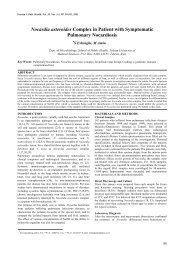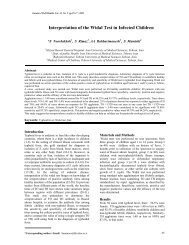Clinical and Laboratory Manifestations of Meningococcemia in ...
Clinical and Laboratory Manifestations of Meningococcemia in ...
Clinical and Laboratory Manifestations of Meningococcemia in ...
Create successful ePaper yourself
Turn your PDF publications into a flip-book with our unique Google optimized e-Paper software.
Iranian J Publ Health, Vol. 35, No. 4, 2006, Iranian pp.49-53 J Publ Health, Vol. 35, No. 4, 2006, pp.49-53<strong>Cl<strong>in</strong>ical</strong> <strong>and</strong> <strong>Laboratory</strong> <strong>Manifestations</strong> <strong>of</strong> <strong>Men<strong>in</strong>gococcemia</strong> <strong>in</strong>ChildrenS Mamishi 1 , S Mostashfi habibabadi 1 ,*B Elahi 11 Dept. <strong>of</strong> Pediatrics, Faculty <strong>of</strong> Medic<strong>in</strong>e, Tehran University <strong>of</strong> Medical Sciences, Iran(Received 1 Jul 2006; accepted 25 Oct 2006)AbstractLack <strong>of</strong> vacc<strong>in</strong>ation <strong>and</strong> modern health care facilities <strong>in</strong> many countries <strong>in</strong>clud<strong>in</strong>g Iran let men<strong>in</strong>gococcemia to rema<strong>in</strong> as aserious challeng<strong>in</strong>g disorder especially among children <strong>and</strong> <strong>in</strong> spite <strong>of</strong> improved diagnosis <strong>and</strong> earlier treatment its prognosisis still dismal. This study describes 68 cases (54.4% male) <strong>of</strong> proved men<strong>in</strong>gococcemia hospitalized s<strong>in</strong>ce 1992 up to theend <strong>of</strong> 2002 <strong>in</strong> Children Medical Center Hospital, Tehran, Iran. Infants <strong>of</strong> 6 to 12 month old were a major concern <strong>in</strong> number(14.7%) <strong>and</strong> severity <strong>of</strong> disease. 5.9% <strong>of</strong> the cases have had at least two hospitalization history for men<strong>in</strong>gococcal septicemia<strong>and</strong> 19.1% <strong>of</strong> the patients had Systemic Lupus Erythematosus (SLE), nephrotic syndrome or chronic liver disease <strong>in</strong>their past medical history. Men<strong>in</strong>geal irritation signs were seen <strong>in</strong> 55.9% <strong>and</strong> cerebrosp<strong>in</strong>al fluid (CSF) smear was positive<strong>in</strong> 71.4% <strong>and</strong> culture was positive <strong>in</strong> 48.5% <strong>of</strong> patients. Men<strong>in</strong>gococcal septicemia ended <strong>in</strong> shock (38.2%), Dissem<strong>in</strong>ated<strong>in</strong>travascular coagulation (DIC) (7.4%), thrombocytopenia (10.3%), arthritis (4.4%),ocular complications (2.9%), pericarditis(2.9%) <strong>and</strong> seizure (8.8%) <strong>in</strong> 51 <strong>of</strong> the cases, <strong>and</strong> death occurred <strong>in</strong> 7 patients. This study shows that the manifestation <strong>of</strong>the disease is similar to those described elsewhere except for lower pneumonia <strong>and</strong> no seasonal variations.Keywords: Neisseria men<strong>in</strong>gitides, <strong>Men<strong>in</strong>gococcemia</strong>, Pediatrics, Men<strong>in</strong>gitis, IranIntroductionMen<strong>in</strong>gococcal <strong>in</strong>fections cont<strong>in</strong>ue to kill <strong>and</strong>disable many children (1-7). There are few publisheddata available expla<strong>in</strong><strong>in</strong>g the morbidity,mortality, <strong>and</strong> different presentation <strong>of</strong> this fataldisease <strong>in</strong> Iranian patients.Rates <strong>of</strong> men<strong>in</strong>gococcal disease <strong>in</strong> the US haverema<strong>in</strong>ed relatively stable, at approximately 0.9to 1.5 cases per 100, 000 persons per year, or2500 to 3000 cases per year but <strong>in</strong> the sub-Saharan"men<strong>in</strong>gitis belt" region where consists <strong>of</strong>the countries extended from Senegal to Ethiopia<strong>in</strong> Africa, serogroup A poses a recurrent threat topublic health, with attack rates up to 500 to 1000cases per 100, 000 population (8-10). Other studieshave also shown occurrence <strong>of</strong> the highest attackrate among young children which is probablydue to immaturity <strong>of</strong> their immune system <strong>in</strong>production <strong>of</strong> protective antibodies (1, 5, 11).Infection by Neisseria men<strong>in</strong>gitides may causeoverwhelm<strong>in</strong>g sepsis, typically characterized byshock <strong>and</strong> a hemorrhagic exanthema, or centralnervous system <strong>in</strong>volvement (12, 13), purpurafulm<strong>in</strong>ans <strong>and</strong> hemodynamic deterioration cont<strong>in</strong>uesto have a mortality <strong>of</strong> more than 50%(14, 15).This high mortality <strong>and</strong> morbidity makes timely<strong>and</strong> correct diagnosis <strong>of</strong> acute febrile childrenwith men<strong>in</strong>gococcemia a dilemma for consideratecl<strong>in</strong>icians, while lack <strong>of</strong> vacc<strong>in</strong>ation <strong>and</strong> moderndiagnostic tools <strong>in</strong> many develop<strong>in</strong>g countriesgive additional significance to cl<strong>in</strong>ical manifestationas a tool for detect<strong>in</strong>g the culprit agentsespecially <strong>in</strong> affected children.Unluckily, there are few published data availablefrom Iran <strong>in</strong>clud<strong>in</strong>g mortality rates <strong>and</strong> serotypes<strong>of</strong> men<strong>in</strong>gococcal <strong>in</strong>fections (16), however;published data have shown similarity betweennature <strong>of</strong> this <strong>in</strong>fection <strong>in</strong> Iran <strong>and</strong>neighbor<strong>in</strong>g countries.In this study, we tried to describe the cl<strong>in</strong>ical <strong>and</strong>laboratory manifestations <strong>of</strong> Neisseria men<strong>in</strong>giti-*Correspond<strong>in</strong>g author: Tel: +98 932 9169287, E-mail: Elahi.behzad@gmail.com49
S Mamishi et al: <strong>Cl<strong>in</strong>ical</strong> <strong>and</strong> <strong>Laboratory</strong>…dis sepsis, as well as the mortalities <strong>and</strong> disabilitieswe are cop<strong>in</strong>g with <strong>in</strong> fight<strong>in</strong>g this life threaten<strong>in</strong>gdisease.Material <strong>and</strong> MethodsIn this retrospective case series study, we reviewedchildren (def<strong>in</strong>ed as patients youngerthan 13 yr old) admitted <strong>in</strong> one <strong>of</strong> the majoraffiliated children’s referral hospitals <strong>of</strong> TehranUniversity <strong>of</strong> Medical Sciences, Iran .We identifiedchildren from April 1992 to April 2002with either primary or f<strong>in</strong>al diagnosis <strong>of</strong> men<strong>in</strong>gococcemiaconfirmed by positive microbiologicalf<strong>in</strong>d<strong>in</strong>gs <strong>of</strong> men<strong>in</strong>gococcal <strong>in</strong>fection.We extracted the demographic <strong>in</strong>formation, cl<strong>in</strong>icalmanifestations, laboratory results, complications,<strong>and</strong> outcome to st<strong>and</strong>ardized data collectionsheets for further analysis.<strong>Men<strong>in</strong>gococcemia</strong> is considered <strong>in</strong> patients withat least one positive blood culture. <strong>Cl<strong>in</strong>ical</strong> signs<strong>of</strong> men<strong>in</strong>gitis (neck stiffness or low level <strong>of</strong> consciousness)were observed <strong>in</strong> 38 patients. Lumbarpuncture for CSF smear <strong>and</strong> culture was performed<strong>in</strong> 52 patients. “Men<strong>in</strong>gitis” was def<strong>in</strong>edas the recovery <strong>of</strong> N. men<strong>in</strong>gitides from samples<strong>of</strong> the CSF <strong>in</strong> association with a CSF pleocytosis<strong>of</strong> ≥ 10 WBCs/mm 3 (if aged> 1 mo), or recovery<strong>of</strong> N. men<strong>in</strong>gitides from a blood culture alonebut with a CSF pleocytosis <strong>of</strong> ≥ 10 WBCs/ mm 3(if aged > 1 mo). Because neonates (≤ 1 mo <strong>of</strong> age)may normally have CSF pleocytosis <strong>of</strong> ≤ 25 WBC/mm 3 , these patients had men<strong>in</strong>gitis accord<strong>in</strong>g tothe aforementioned criteria if they had a CSFpleocytosis > 25 WBC/ mm 3 (17).Pericardial effusion was diagnosed by means <strong>of</strong>echocardiography. Seizure activity was determ<strong>in</strong>edbased on a description <strong>in</strong> a progress noteor a discharge diagnosis.Permanent or long-last<strong>in</strong>g complications <strong>of</strong> thedisease were registered <strong>in</strong>clud<strong>in</strong>g scarr<strong>in</strong>g secondaryto localized sk<strong>in</strong> loss, partial or completeamputations, conjunctivitis, arthritis, <strong>and</strong> neurologicalimpairments, <strong>in</strong>clud<strong>in</strong>g seizures. Epilepsyconsidered as a complication <strong>of</strong> men<strong>in</strong>gococcaldisease if patients were discharged onanticonvulsant medication. Unfortunately, lack<strong>of</strong> proper audiometric evaluation resulted <strong>in</strong> <strong>in</strong>conclusive<strong>in</strong>formation about hear<strong>in</strong>g loss.Patients with an altered immune status ow<strong>in</strong>g tothe use <strong>of</strong> immunosuppressive drugs or splenectomy,diabetes mellitus, nephrotic syndromeor chronic liver disorders were considered immunecompromised, as were patients <strong>in</strong>fectedwith the human immunodeficiency virus orthose with recurrent men<strong>in</strong>gococcal <strong>in</strong>fections.ResultsWe identified 68 children (54.4% male <strong>and</strong> medianage <strong>of</strong> 5 yr old) with culture proven men<strong>in</strong>gococcaldisease; all <strong>of</strong> them had cl<strong>in</strong>ical signsfor overt men<strong>in</strong>gococcal disease. Lumbar puncture(LP) was done on 52 patients, <strong>of</strong> whom 35had neck stiffness <strong>and</strong> men<strong>in</strong>geal irritation signs,while 16 patients underwent LP without anysign <strong>of</strong> men<strong>in</strong>geal irritation, on the other h<strong>and</strong>there was two patients who had neck stiffnessbut LP was not done or failed to extract enoughCSF sample for analysis. Neisseria men<strong>in</strong>gitidisisolated <strong>in</strong> CSF smear <strong>of</strong> 25 (71.4%) patientswith neck stiffness or other men<strong>in</strong>geal irritationsigns <strong>and</strong> CSF culture was positive among 17patients <strong>of</strong> whom 11 had both positive CSFsmear <strong>and</strong> culture for N.men<strong>in</strong>gitidis.In our study, 20.6% <strong>of</strong> our patients were between4 to 6 yr old (median 5 yr) <strong>and</strong> 14.7% werebetween 6 to 12 mo. <strong>Men<strong>in</strong>gococcemia</strong> werepresented with rash, shock <strong>and</strong> men<strong>in</strong>gitis onadmission (Table 1). Seasonal change on diseaseoccurrence was <strong>in</strong>significant (Chi-square X 2 =0.92) with the lowest occurrence <strong>of</strong> diseasebetween July <strong>and</strong> November.Thirteen patients had altered immune system withchronic conditions such as chronic liver disorders,SLE or nephrotic syndrome <strong>and</strong> four patients hadrecurrent <strong>in</strong>fections with Neisseria men<strong>in</strong>gitis.Complications occurred <strong>in</strong> a major number <strong>of</strong> thepatients (Table 2.). Seven patients died (10.3%);two <strong>of</strong> them had men<strong>in</strong>geal signs <strong>and</strong> 5 had severesepsis <strong>and</strong> respiratory failure.50
Iranian J Publ Health, Vol. 35, No. 4, 2006, pp.49-53Table 1: Results <strong>of</strong> the blood culture <strong>and</strong> smear CSF exam<strong>in</strong>ations <strong>and</strong> cl<strong>in</strong>ical signs <strong>in</strong> patients with men<strong>in</strong>gococcemia<strong>Cl<strong>in</strong>ical</strong> or <strong>Laboratory</strong> F<strong>in</strong>d<strong>in</strong>gs Measured or Observed Variables n (%)Headache 38 (55.9)Symptoms at presentationNeck stiffness 38 (55.9)Rash 44 (64.7)Shock 26 (38.2)Blood count <strong>and</strong> sedimentation rateESR (>30mm/hr) 7 (10.3)Leucopenia (WBC
S Mamishi et al: <strong>Cl<strong>in</strong>ical</strong> <strong>and</strong> <strong>Laboratory</strong>…tered was amputation <strong>and</strong> sk<strong>in</strong> defects (22).This discrepancy orig<strong>in</strong>ated from the differentperiods <strong>of</strong> follow-up. At the present study, weconsidered immediate <strong>and</strong> delayed complications,which had occurred dur<strong>in</strong>g admission oron the first post admission visit.Men<strong>in</strong>gitis has been reported to occur <strong>in</strong> 57%-93% <strong>of</strong> patients with men<strong>in</strong>gococcal disease (1,3, 6, 18, 19). We found 55.9% <strong>of</strong> the patientswith cl<strong>in</strong>ical <strong>and</strong> laboratory signs <strong>of</strong> men<strong>in</strong>gitis.Rash was observed <strong>in</strong> 64.7% <strong>of</strong> the cases, whilethis sign had a range <strong>of</strong> 7.3% to 100% <strong>of</strong> thecases <strong>in</strong> other studies (18,23) <strong>in</strong> a recently publishedarticle <strong>in</strong> New Engl<strong>and</strong> journal <strong>of</strong> Medic<strong>in</strong>eoccurrence <strong>of</strong> rash was significantly relatedto unfavorable outcome among patientswith men<strong>in</strong>gococcal men<strong>in</strong>gitis(24).We found 25% <strong>of</strong> the patients with the backgroundhistory <strong>of</strong> recurrent men<strong>in</strong>gococcal <strong>in</strong>fections(5.9%), or a chronic debilitat<strong>in</strong>g disorder(nephrotic syndrome, chronic liver disease,or SLE) (19.1%).However, lack <strong>of</strong> appropriate serological diagnostictest <strong>and</strong> poor economic condition <strong>in</strong> develop<strong>in</strong>gcountries limit this study <strong>in</strong> many aspects.Unsuspected men<strong>in</strong>gococcal <strong>in</strong>fection whichconsists <strong>of</strong> those cases who had managed outpatiently did not <strong>in</strong>clude <strong>in</strong> this study. Also wedid not have enough data concern<strong>in</strong>g the serogroup<strong>of</strong> N. men<strong>in</strong>gitides <strong>in</strong> our patients.In brief this study reviews men<strong>in</strong>gococcal disease<strong>in</strong> children at one <strong>of</strong> the academic pediatricreferral hospitals <strong>in</strong> Tehran for 10 yr; althoughthe majority <strong>of</strong> patients had men<strong>in</strong>gitis, the fullrange <strong>of</strong> the manifestations was also seen. <strong>Manifestations</strong><strong>of</strong> the disease were similar to thosedescribed elsewhere, with the exception <strong>of</strong> thepneumonia <strong>and</strong> seasonal variations, which werarely observed.AcknowledgmentsAuthors want to thank Pr<strong>of</strong>essor A Siadati, forhis k<strong>in</strong>d guidance <strong>and</strong> for his cont<strong>in</strong>ued support<strong>of</strong> our work, <strong>and</strong> we also thank Pr<strong>of</strong>essor Bavarian<strong>and</strong> Dr Elahi for their precious consultations<strong>and</strong> revision <strong>of</strong> the manuscript. This studywas conducted without any external funds <strong>and</strong>was accepted for poster presentation <strong>in</strong> Medic<strong>in</strong>e<strong>and</strong> Health <strong>in</strong> Tropics, Marseille- FranceSeptember 2004.References1. Jafari HS, Perk<strong>in</strong>s BA, Wenger JD (1997).Control <strong>and</strong> prevention <strong>of</strong> men<strong>in</strong>gococcaldisease: recommendations <strong>of</strong> theAdvisory Committee on ImmunizationPractices (ACIP). MMWR Morb MortalWkly Rep, 46: 1-10.2. S<strong>in</strong>gh J, Arrieta AC (2004). Management<strong>of</strong> men<strong>in</strong>gococcemia. Indian J Pediatr,71(10): 909-13.3. Kirsch EA, Barton RP, Kitchen L, GiroirBP (1996). Pathophysiology, treatment<strong>and</strong> outcome <strong>of</strong> men<strong>in</strong>gococcemia: a review<strong>and</strong> recent experience. Pediatr InfectDis J, 15:967-79.4. Riedo FX, Plikaytis BD, Broome CV(1995). Epidemiology <strong>and</strong> prevention <strong>of</strong>men<strong>in</strong>gococcal disease. Pediatr InfectDis J, 14: 643-57.5. American Academy <strong>of</strong> Pediatrics, Committeeon Infectious Diseases; Canadian PaediatricSociety, Infectious Diseases <strong>and</strong>Immunization Committee (1996). Men<strong>in</strong>gococcaldisease prevention <strong>and</strong> controlstrategies for practice-based physicians.Pediatrics, 97:404-12.6. Whalen CM, Hock<strong>in</strong> JC, Ryan A, Ashton F(1995). The chang<strong>in</strong>g epidemiology <strong>of</strong><strong>in</strong>vasive men<strong>in</strong>gococcal disease <strong>in</strong> Canada,1985 through 1992. Emergence <strong>of</strong> avirulent clone <strong>of</strong> Neisseria men<strong>in</strong>gitidis.JAMA, 273: 390-94.7. Mok Q, Butt W (1996). The outcome <strong>of</strong>children admitted to <strong>in</strong>tensive care withmen<strong>in</strong>gococcal septicaemia. Intensive CareMed, 22: 259-63.8. S<strong>in</strong>gh J, Arrieta AC (2004). Management <strong>of</strong>men<strong>in</strong>gococcemia. Indian J Pediatr, 71:909-13.52
Iranian J Publ Health, Vol. 35, No. 4, 2006, pp.49-539. Rosenste<strong>in</strong> NE, Perk<strong>in</strong>s BA, Stephens DS,Popovic T, Hughes JM (2001). EpidemiologicFeatures <strong>of</strong> Men<strong>in</strong>gococcal Disease.N Engl J Med, 344(18): 1378-88.10. Men<strong>in</strong>gococcal disease <strong>in</strong> the African Men<strong>in</strong>gitisBelt (WHO website) (2002). Availablefrom: http://www.who.<strong>in</strong>t/disease-outbreak-News/n2002/april/10april2002.html.11. Jackson LA, Wenger JD (1993). <strong>Laboratory</strong>-basedsurveillance for men<strong>in</strong>gococcaldisease <strong>in</strong> selected areas, UnitedStates, 1989-1991. MMWR CDC SurveillSumm, 42: 21-30.12. Kirsch EA, Barton RP, Kitchen L, GiroirBP (1996). Pathophysiology, treatment<strong>and</strong> outcome <strong>of</strong> men<strong>in</strong>gococcemia: a review<strong>and</strong> recent experience (see comments).Pediatr Infect Dis J, 15:967-78.13. Wong VK, Hitchcock W, Mason WH (1989).Men<strong>in</strong>gococcal <strong>in</strong>fections <strong>in</strong> children: areview <strong>of</strong> 100 cases. Pediatr Infect DisJ, 8: 224-27.14. Havens PL, Garl<strong>and</strong> JS, Brook MM, DewitzBA, Stremski ES, Troshynski TJ (1989).Trends <strong>in</strong> mortality <strong>in</strong> children hospitalizedwith men<strong>in</strong>gococcal <strong>in</strong>fections,1957 to 1987. Pediatr Infect Dis J, 8: 8-11.15. Giraud T, Dha<strong>in</strong>aut JF, Schremmer B, RegnierB, Desjars P, Loirat P et al. (1991).Adult overwhelm<strong>in</strong>g men<strong>in</strong>gococcal purpura:a study <strong>of</strong> 35 cases, 1977-1989.Arch Intern Med, 151: 310-16.16. Emami Nae<strong>in</strong>i A (2005). Importance <strong>of</strong> Scor<strong>in</strong>gSystems <strong>in</strong> Prognosticat<strong>in</strong>g <strong>Men<strong>in</strong>gococcemia</strong>.Journal <strong>of</strong> Research <strong>in</strong>Medical Sciences, 1: 34-37.17. Got<strong>of</strong>f SP (2000). Infections <strong>of</strong> the neonatal<strong>in</strong>fant: laboratory diagnosis. In: Nelsontextbook <strong>of</strong> pediatrics. Eds Behrman RE,Kliegman RM, Jenson HB, W. B. Saunders.16 th Ed, New York, pp. 548-49.18. Wang VJ, Kuppermann N, Malley R, BarnettED, Meissner HC et al. (2001).Men<strong>in</strong>gococcal Disease among ChildrenWho Live <strong>in</strong> a Large Metropolitan Area,1981-1996. Cl<strong>in</strong> Infect Dis, 32(1): 1004-9.19. Edwards MS, Baker CJ (1981). Complications<strong>and</strong> sequelae <strong>of</strong> men<strong>in</strong>gococcal <strong>in</strong>fections<strong>in</strong> children. J Pediatr, 99: 540-45.20. Jackson LA, Wenger JD (1993). <strong>Laboratory</strong>-basedsurveillance for men<strong>in</strong>gococcaldisease <strong>in</strong> selected areas, UnitedStates, 1989-1991. MMWR Morb MortalWkly Rep CDC Surveill Summ, 42:21-30.21. Havens PL, Garl<strong>and</strong> JS, Brook MM, DewitzBA, Stremski ES, Troshynski TJ (1989).Trends <strong>in</strong> mortality <strong>in</strong> children hospitalizedwith men<strong>in</strong>gococcal <strong>in</strong>fections,1957-1987. Pediatr Infect Dis J, 8:8-11.22. Erickson L, De Wals P (1998). Complications<strong>and</strong> sequelae <strong>of</strong> men<strong>in</strong>gococcaldisease <strong>in</strong> Quebec, Canada, 1990-1994.Cl<strong>in</strong> Infect Dis, 26(5):1159-64.23. M<strong>and</strong>l KD, Stack AM, Fleisher GR (1997).Incidence <strong>of</strong> bacteremia <strong>in</strong> <strong>in</strong>fants <strong>and</strong>children with fever <strong>and</strong> petechiae. J Pediatr,131(3):398-404.24. Van de Beek D, de Gans J, Spanjaard L,Weisfelt M, Reitsma JB, Vermeulen M(2004). <strong>Cl<strong>in</strong>ical</strong> Features <strong>and</strong> PrognosticFactors <strong>in</strong> Adults with Bacterial Men<strong>in</strong>gitis.N Engl J Med, 351(18):1849-59.53


